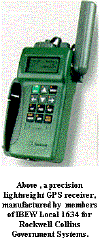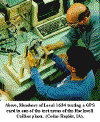Technology
Beat
THE GLOBAL POSITIONING SYSTEM (GPS)
December 1998 IBEW Journal
What a marvel to navigate a course on land, sea or air using
the global positioning system (GPS). GPS is a radionavigation
system consisting of three basic parts: a satellite component
consisting of 24 Navstar satellites orbiting the Earth 11,000 nautical
miles away; a ground-based monitoring component consisting
of five monitoring stations, three ground antennas and a Master
Control Station (see map); and a user component consisting
of antennas and receiver/processors that report position, velocity
and precise timing to the user. In summary, working together these
GPS components can precisely locate the user’s position anywhere
on the globe.
 The
preciseness of the GPS measurements varies, depending on the level
of service that the user is permitted to access. The Precise
Positioning Service (PPS) is available to military and
other authorized users and is the most accurate. The Standard
Positioning Service (SPS) is available to civilian and
commercial users. In addition, a technology developed by the U.S.
Coast Guard can augment the precision of SPS. This error-correcting
technology is called the differential global positioning system
(DGPS). The
preciseness of the GPS measurements varies, depending on the level
of service that the user is permitted to access. The Precise
Positioning Service (PPS) is available to military and
other authorized users and is the most accurate. The Standard
Positioning Service (SPS) is available to civilian and
commercial users. In addition, a technology developed by the U.S.
Coast Guard can augment the precision of SPS. This error-correcting
technology is called the differential global positioning system
(DGPS).
History of GPS
The U.S. Department of Defense (DOD) began construction of
a sophisticated satellite positioning system in the mid 1970s to
permit military ships, aircraft and ground-based vehicles to determine
their location anywhere in the world. DOD began launching Navstar
GPS satellites in the late 1980s. In April 1995 the U.S. Air Force
Space Command (AFSC) announced that the constellation of 24 Navstar
GPS satellites was fully operational.
For purposes of U.S. national security, DOD developed an encryption
technology to guard the satellites’ signals from being corrupted.
This technology called selective availability encrypts the
signals by introducing slight error in the satellites’ atomic
clocks, a timekeeping component. With PPS, the military and
other authorized users can decode the encrypted signals to get precise
measurements and time. Position accuracy for the military is within
15 meters. With SPS, civilian and commercial users do not
have access to decode the encrypted signals, so the receiver’s
time, velocity and position calculations are not as precise. Position
accuracy for SPS users is within 100 meters.
Components of GPS Satellites Each satellite weighs approximately
2,000 pounds, provides 24 hours of daily coverage, and has a lifespan
of 7.5 years. Each satellite is inclined at an angle of 55 to the
equatorial plane and orbits the Earth in a circular path every 12
hours. There are four satellites in each of six different orbital
planes, equally spaced 60 apart.
These satellites are tracked by five ground stations, three antennas,
and a Master Control Station (MCS) at Schriever Air Force Base in
Colorado. The MCS collects data from the five ground stations and
calculates each satellites’ orbital data (ephemeris), frequency
drift, frequency error, and clock time error. The ground antennas
upload this information to the satellites for the satellites to
broadcast accurate position and time.
Each GPS satellite has a main body and two wing-type
solar arrays.
The main body is made up of about 65,000 parts, including
12 antennas, four atomic clocks and a transmitter. The transmitter
broadcasts the timed electromagnetic signals (or radio signals)
at high frequency reaching to all areas of the Earth. SPS transmits
on the L1 frequency (1575.42 MHZ), and PPS uses the L1 and L2 frequencies.
The L2 frequency is 1227.6 MHZ.The signals are encrypted
with time and navigation data. Antennas are positioned toward
the Earth and pick up orbit-correction data computed from the Master
Control Station and uploaded by the ground antennas. The atomic
clocks used in the GPS system are referenced to the United States
Naval Observatory’s (USNO) Master Clock, which follows Coordinated
Universal Time (UTC). UTC replaces Greenwich Mean Time (GMT) as
the world’s official time. Each satellite has four clocks in
case one stops or malfunctions.
On either side of the satellite’s main body are wing-type
solar arrays. These are positioned toward the Sun and convert
the solar energy to approximately 710 watts of electricity, which
activates the satellites’ transmitters to broadcast timed navigation
pulses to GPS receivers.
Components of GPS Receivers
 There
are two types of GPS receivers, roving and stationary. Each GPS
receiver has an antenna and a timekeeping component such as a quartz-crystal
clock. The antenna receives the satellites’ transmitted
radio signals. The timekeeping component aids in a receiver’s
rapid internal calculations of the signals’ departure times
from any four Navstar satellites and their arrival times at the
receiver’s antenna. These complex calculations result in accurate
position, velocity, and time — latitude, longitude, altitude,
course and speed. There
are two types of GPS receivers, roving and stationary. Each GPS
receiver has an antenna and a timekeeping component such as a quartz-crystal
clock. The antenna receives the satellites’ transmitted
radio signals. The timekeeping component aids in a receiver’s
rapid internal calculations of the signals’ departure times
from any four Navstar satellites and their arrival times at the
receiver’s antenna. These complex calculations result in accurate
position, velocity, and time — latitude, longitude, altitude,
course and speed.
1) A receiver’s position is determined by calculating
the distance between a receiver and any four satellites. The distance
is equal to the signals’ travel time multiplied by the speed
of light. Travel time is the difference between the time a signal
departs from a satellite and the time it arrives at the GPS receiver.
The distance measurements from the four satellites are then compared
and adjusted to coincide with the satellites’ orbit-correction
data.
(2) A receiver’s velocity is determined by calculating
the changes in the receiver’s position over time and/or by
the satellite’s Doppler frequencies.
(3) A receiver’s time is set to GPS satellite atomic
clock time.
Innovative GPS Applications
IBEW members have been very involved in GPS technology
for several years. Working at the Rockwell Collins Government Systems’
plant in Coralville, Iowa, members of IBEW Local Union 1634
manufacture military standard handheld and vehicular, aircraft and
missile GPS receivers. IBEW Local Union 1362 also manufactures
GPS receivers at the Rockwell Collins plant in Cedar Rapids.
Both individuals and industries are utilizing the global positioning
system in numerous ways. GPS can guide hikers over unknown terrain,
pleasure boats into foggy harbors and passenger cars along unfamiliar
routes. The system assists in commercial aircraft navigation, monitors
the movement of cargo containers on ships in port, and assists the
railroad industry in mapping the location of railroad tracks, their
structures and features. Currently, the railroad industry is involved
in testing different GPS applications. Geologists use GPS surveying
equipment to measure small movements in the Earth’s crust and
to locate areas prone to earthquakes. Farmers rely on GPS data for
precision farming, which is a technique for applying agricultural
products to specific sites on a field through the aid of a digitized
map showing the varying soil characteristics of that field.
The twenty-first century holds great promise for continued exploration
of ways to utilize the information provided by that constellation
of 24 Navstar satellites orbiting the Earth 11,000 nautical miles
away.

|
